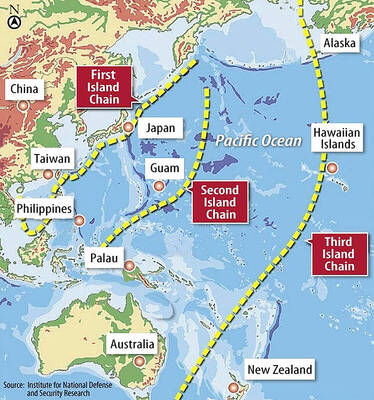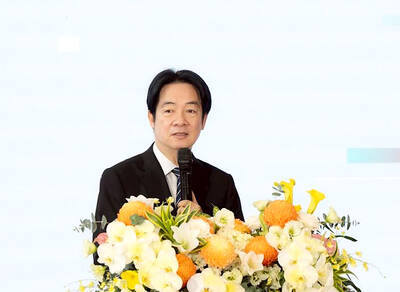Advanced Micro Devices Inc (AMD) yesterday said it is collaborating with Taiwan Semiconductor Manufacturing Co (TSMC, 台積電) to produce its next-generation chips utilizing the 3-nanometer process technology of the world’s biggest foundry service provider.
AMD’s remarks came amid speculation that the US-based chip company might consider adopting Samsung Electronics Co’s 3-nanometer process technology, given that supply of TSMC’s 3-nanometer process technology is constrained.
“AMD is always going to use the most advanced technology and we are certainly going to use 3-nanometer. We’re certainly going to use 2-nanometer and beyond,” AMD chief executive officer Lisa Su (蘇姿丰) told a media briefing following her keynote speech at the Computex Taipei trade show.

Photo: Ritchie B. Tongo, EPA-EFE
AMD “did not say specifically that we’re going to use any particular vendor for 3-nanometer or gate-all-around [GAA]. Our current partnership with TSMC is very strong. We talked about some of the products in 3-nanometer that we are doing right now,” Su said in response to a reporter asking if she had implied that Samsung had been picked because of its GAA technology.
Su last week attended the Imec ITF World 2024 conference in Belgium and unveiled the firm’s plan to mass-produce next-generation chips using 3-nanometer GAA technology at a forum, the Korean Economic Daily reported on Wednesday last week.
Samsung is the only chipmaker to produce 3-nanometer chips based on GAA technology, or a nanobar technology, a major shift from the existing FinFET technology.
Similarly, TSMC also plans to migrate to a new transistor architecture called nanosheet transistor technology for its 2-nanometer chips with higher transistor density and more power efficiency.
TSMC plans to start volume production of 2-nanometer chips next year.
AMD yesterday kept a low-key attitude about its investment in a new research-and-development (R&D) center in Taiwan, when asked about the project that is reportedly costing about NT$5 billion (US$154 million).
“Taiwan is a very important area for us to do research and development,” Su said.
AMD already has more than 1,000 employees in Taiwan taking care of a significant amount of development for a wide range of the company’s product portfolio, including PCs and data centers, as well as our supply-chain partnerships, Su said.
“We are always looking at how we partner in R&D in the region,” Su said.
“So we are continuing to look at what we do in Taiwan. I probably do not have any exact information on the R&D centers at this moment, but we’re looking at all of these,” she said.
Taiwan is “very, very important to the semiconductor ecosystem,” Su said. “We do a lot of manufacturing here with, you know, key suppliers like TSMC, like many of our back-end partners, and many of our substrate partners are here as well.”
AMD has a number of partners that help it build out the ecosystem in Taiwan, such as its contract manufacturers and original-design-manufacturing partners, Su said.
“We are very much a believer in a global semiconductor supply chain,” Su said.
The Ministry of Economic Affairs last week confirmed that AMD had submitted an investment plan, indicating its intention to set up a R&D center in Taiwan under the government’s A+ Industrial Innovative R&D Program.
If the investment plan is approved, AMD could get a substantial subsidy from the government.
Nvidia Corp is reportedly looking at setting up a second R&D facility in Taiwan.
The chip supplier set up its first R&D center focusing on artificial intelligence technologies with a total investment of NT$24.3 billion over a five-year period to 2027. It received about NT$6.7 billion in government subsidies, the ministry said.
Meanwhile, in her keynote speech at Computex, Su announced AMD's new AI chips for everything from cutting-edge data centers to advanced laptops, and said the company's next-generation processors will rival the top offerings from competitors, including market leader Nvidia.
"AI is our number one priority, and we're at the beginning of an incredibly exciting time for the industry as AI transforms virtually every business, improves our quality of life and reshapes every part of the computing market," Su said.
She also announced that AMD will follow an annual update cycle for its advanced accelerators, and the latest — the Instinct MI325X — is planned for release later this year.
Additional reporting by AFP

MISINFORMATION: The generated content tends to adopt China’s official stance, such as ‘Taiwan is currently governed by the Chinese central government,’ the NSB said Five China-developed artificial intelligence (AI) language models exhibit cybersecurity risks and content biases, an inspection conducted by the National Security Bureau (NSB) showed. The five AI tools are: DeepSeek, Doubao (豆包), Yiyan (文心一言), Tongyi (通義千問) and Yuanbao (騰訊元寶), the bureau said, advising people to remain vigilant to protect personal data privacy and corporate business secrets. The NSB said it, in accordance with the National Intelligence Services Act (國家情報工作法), has reviewed international cybersecurity reports and intelligence, and coordinated with the Ministry of Justice Investigation Bureau and the National Police Agency’s Criminal Investigation Bureau to conduct an inspection of China-made AI language

LIMITS: While China increases military pressure on Taiwan and expands its use of cognitive warfare, it is unwilling to target tech supply chains, the report said US and Taiwan military officials have warned that the Chinese People’s Liberation Army (PLA) could implement a blockade within “a matter of hours” and need only “minimal conversion time” prior to an attack on Taiwan, a report released on Tuesday by the US Senate’s China Economic and Security Review Commission said. “While there is no indication that China is planning an imminent attack, the United States and its allies and partners can no longer assume that a Taiwan contingency is a distant possibility for which they would have ample time to prepare,” it said. The commission made the comments in its annual

DETERMINATION: Beijing’s actions toward Tokyo have drawn international attention, but would likely bolster regional coordination and defense networks, the report said Japanese Prime Minister Sanae Takaichi’s administration is likely to prioritize security reforms and deterrence in the face of recent “hybrid” threats from China, the National Security Bureau (NSB) said. The bureau made the assessment in a written report to the Legislative Yuan ahead of an oral report and questions-and-answers session at the legislature’s Foreign Affairs and National Defense Committee tomorrow. The key points of Japan’s security reforms would be to reinforce security cooperation with the US, including enhancing defense deployment in the first island chain, pushing forward the integrated command and operations of the Japan Self-Defense Forces and US Forces Japan, as

‘TROUBLEMAKER’: Most countries believe that it is China — rather than Taiwan — that is undermining regional peace and stability with its coercive tactics, the president said China should restrain itself and refrain from being a troublemaker that sabotages peace and stability in the Indo-Pacific region, President William Lai (賴清德) said yesterday. Lai made the remarks after China Coast Guard vessels sailed into disputed waters off the Senkaku Islands — known as the Diaoyutai Islands (釣魚台) in Taiwan — following a remark Japanese Prime Minister Sanae Takaichi made regarding Taiwan. Takaichi during a parliamentary session on Nov. 7 said that a “Taiwan contingency” involving a Chinese naval blockade could qualify as a “survival-threatening situation” for Japan, and trigger Tokyo’s deployment of its military for defense. Asked about the escalating tensions